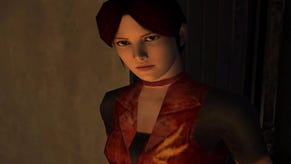Resident Evil: Code Veronica HD
Polishing the CV.
Likewise, you must click a button to climb stairs (a decision intended to slow you down and induce panic when fleeing). The click-X-on-everything interaction with game worlds that defined so many PlayStation-era adventure games remains here, a design that makes your character feel superimposed onto the backgrounds rather than an embedded part of the world.
Every few seconds, key objects in the environment glint to draw your attention, an unimaginative and lazy design trope now largely consigned to history. You save your progress at typewriters that require ink ribbons before they'll record your progress: an artificial limitation of your ability to step out of the game that feels wholly anachronistic.
The lengthy load times between rooms were originally placed to increase the sense of tension as you move through the game while simultaneously covering the disc access. In 2011, the load time consideration has no relevance, leaving the ponderous door opening animations an aesthetic choice that has lost its impact.
While players who enjoyed the game in 2000 will view these limitations as part of the authentic survival horror experience of the time, few newcomers will see them as anything other than obsolete annoyances. Indeed, in terms of raw interactions, the Famicom's Sweet Home (the first survival horror game, from which Mikami drew inspiration when planning the first Resident Evil) is by far the more playable proposition today.
And yet, if you can accept these interactive barriers as relics of the game's era, the jewels in Code Veronica's design have lost little of their shine. This is a puzzle-heavy game - more so than the first three Resident Evils - and Capcom's raw ingenuity regularly sparkles here. The cinematic shocks are just as effective today as ever, and even where the 3D models look outdated, the poised enemy animations help infuse these blocky cadavers with threat that still chills.
There is a frenetic pace to the game and the switching between protagonists contributes to the theatrics, allowing the designers to view scenarios from multiple viewpoints in an effective way. The cameras are wonderfully directed, contributing to the sense of dread - and while the dialogue and acting is nothing short of atrocious, the B-movie plotline races along, rarely allowing you time to notice.
The item management side of the game, which has you deliberating over which assets to leave behind when your inventory fills up, remains effective and as much a source of the survivalist horror as the shambling zombies. While the ambiguous controls grate at first, the game's peculiar rhythms do have a certain, shuffling charm, once you're acclimatised.
Resident Evil: Code Veronica is a relic of a bygone era that Capcom has done nothing to reinvent for modern audiences with this reissue. Yet beneath its off-putting anachronisms there is a worthwhile, menacing game - for those with the eyes to catch it.






















